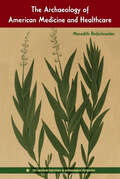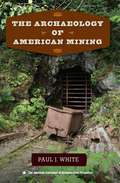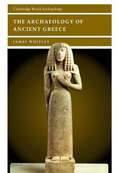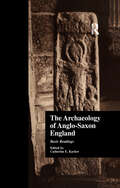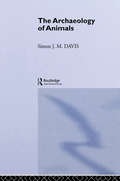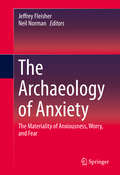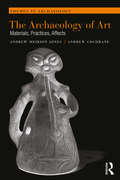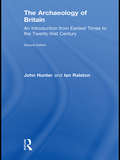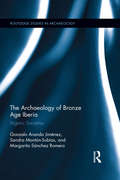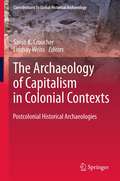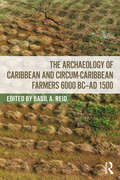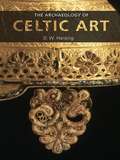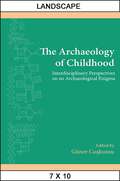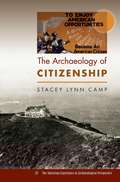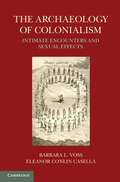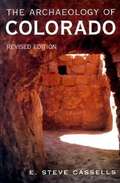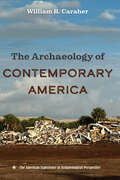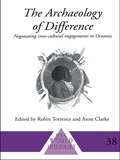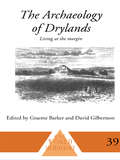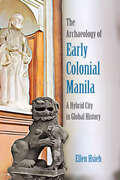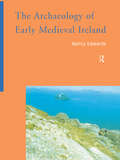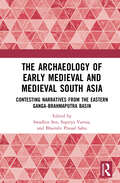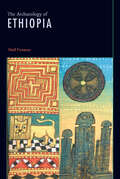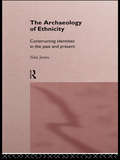- Table View
- List View
The Archaeology of American Medicine and Healthcare (The American Experience in Archaeological Perspective)
by Meredith ReifschneiderExamining the dynamic histories of medical practice in the United States through the lens of historical archaeology In this book, Meredith Reifschneider synthesizes archaeological research on healthcare and medicine to show how practices in the United States have evolved since the nineteenth century. Tracing the areas of medical science and healthcare professionalization, alternative medicine, healthcare consumerism, and public health reform, Reifschneider shows how historical archaeology—which draws on information from the material record, archival sources, historical documents, and ethnographic research—can provide important insights into healthcare and modes of self-care in the past. Reifschneider analyzes archaeological evidence uncovered from sites such as house deposits, middens, latrines, and hospital waste pits that demonstrates how official healthcare policies were implemented in daily life, revealing a diversity of therapeutic practices connected to social identities. The book includes a case study of the US Army’s hygiene and healthcare practices at the Presidio of San Francisco, showing how soldiers engaged in practices mandated by the government while also using alternative therapies for self-care. Throughout the book, Reifschneider highlights structural health inequalities in the past and how the effects of previous exclusionary policies continue to manifest in the present day. By examining healthcare and medicine through the lens of archaeology, this book demonstrates the dynamic and often unexpected histories of medical practice, pointing to the ways Americans’ experiences today reflect these historical dynamics. A volume in the series the American Experience in Archaeological Perspective, edited by Michael S. Nassaney and Krysta Ryzewski
The Archaeology of American Mining (The American Experience in Archaeological Perspective)
by Paul J. WhiteMining History Association Clark C. Spence Award The mining industry in North America has a rich and conflicted history. It is associated with the opening of the frontier and the rise of the United States as an industrial power but also with social upheaval, the dispossession of indigenous lands, and extensive environmental impacts. Synthesizing fifty years of research on American mining sites that date from colonial times to the present, Paul White provides an ideal overview of the field for both students and professionals. The Archaeology of American Mining offers a multifaceted look at mining, incorporating findings from an array of subfields, including historical archaeology, industrial archaeology, and maritime archaeology. Case studies are taken from a wide range of contexts, from eastern coal mines to Alaskan gold fields, with special attention paid to the domestic and working lives of miners. Exploring what material artifacts can tell us about the lives of people who left few records, White demonstrates how archaeologists contribute to our understanding of the legacies left by miners and the mining industry. A volume in the series the American Experience in Archaeological Perspective, edited by Michael S. Nassaney
The Archaeology of Ancient Greece (Cambridge World Archaeology)
by Stephen Shennan Norman Yoffee James Whitley Susan Alcock Tom Dillehay Carla SinopoliThe Archaeology of Ancient Greece provides an up-to-date synthesis of current research on the material culture of Greece in the Archaic and Classical periods. Its rich and diverse material has always provoked admiration and even wonder, but it is seldom analyzed as a key to our understanding of Greek civilization. Dr. Whitley shows how the material evidence can be used to address central historical questions for which literary evidence is often insufficient, and he also situates Greek art within the broader field of Greek material culture.
The Archaeology of Anglo-Saxon England: Basic Readings (Basic Readings in Anglo-Saxon England #9)
by Catherine E. KarkovThis volume offers comprehensive coverage of the archaeology of Anglo-Saxon England, bringing together essays on specifi fields, sites and objects, and offering the reader a representative range of both traditional and new methodologies and interdisciplinary approaches to the subject.
The Archaeology of Animals
by Simon J. DavisEver since the discovery of fossil remains of extinct animals associated with flint implements, bones and other animal remains have been providing invaluable information to the archaeologist. In the last 20 years many archaeologists and zoologists have taken to studying such "archaeofaunal" remains, and the science of "zoo-archaeology" has come into being. What was the nature of the environment in which our ancestors lived? In which season were sites occupied? When did our earliest ancestors start to hunt big game, and how efficient were they as hunters? Were early humans responsible for the extinction of so many species of large mammals 10-20,000 years ago? When, where and why were certain animals first domesticated? When did milking and horse-riding begin? Did the Romans influence our eating habits? What were sanitary conditions like in medieval England? And could the terrible pestilence which afflicted the English in the seventh century AD have been plague? These are some of the questions dealt with in this book. The book also describes the nature and development of bones and teeth, and some of the methods used in zoo-archaeology.
The Archaeology of Anxiety
by Jeffrey Fleisher Neil NormanRecent efforts to engage more explicitly with the interpretation of emotions in archaeology have sought new approaches and terminology to encourage archaeologists to take emotions seriously. This is part of a growing awareness of the importance of senses--what we see, smell, hear, and feel--in the constitution and reconstitution of past social and cultural lives. Yet research on emotion in archaeology remains limited, despite the fact that such states underpin many studies of socio-cultural transformation. The Archaeology of Anxiety draws together papers that examine the local complexities of anxiety as well as the variable stimuli--class or factional struggle, warfare, community construction and maintenance, personal turmoil, and responsibilities to (and relationships with) the dead--that may generate emotional responses of fear, anxiousness, worry, and concern. The goal of this timely volume is to present fresh research that addresses the material dimension of rites and performances related to the mitigation and negotiation of anxiety as well as the role of material culture and landscapes in constituting and even creating periods or episodes of anxiety.
The Archaeology of Art: Materials, Practices, Affects (Themes in Archaeology Series)
by Andrew Cochrane Andrew Meirion JonesHow can archaeologists interpret ancient art and images if they do not treat them as symbols or signifiers of identity? Traditional approaches to the archaeology of art have borrowed from the history of art and the anthropology of art by focusing on iconography, meaning, communication and identity. This puts the archaeology of art at a disadvantage as an understanding of iconography and meaning requires a detailed knowledge of historical or ethnographic context unavailable to many archaeologists. Rather than playing to archaeology’s weaknesses, the authors argue that an archaeology of art should instead play to archaeology’s strength: the material character of archaeological evidence. Using case studies - examining rock art, figurines, beadwork, murals, coffin decorations, sculpture and architecture from Europe, the Americas, Asia, Australia, and north Africa -the authors develop an understanding of the affective and effective nature of ancient art and imagery. An analysis of a series of material-based practices, from gesture and improvisation to miniaturisation and gigantism, assembly and disassembly and the use of distinctions in colour enable key concepts, such as style and meaning, to be re-imagined as affective practices. Recasting the archaeology of art as the study of affects offers a new prospectus for the study of ancient art and imagery.
The Archaeology of Britain: An Introduction from Earliest Times to the Twenty-First Century
by John Hunter Ian RalstonThe Archaeology of Britain is the only concise and up-to-date introduction to the archaeological record of Britain from the reoccupation of the landmass by Homo sapiens during the later stages of the most recent Ice Age until last century. This fully revised second edition extends its coverage, including greater detail on the first millennium AD beyond the Anglo-Saxon domain, and into recent times to look at the archaeological record produced by Britain’s central role in two World Wars and the Cold War. The chapters are written by experts in their respective fields. Each is geared to provide an authoritative but accessible introduction, supported by numerous illustrations of key sites and finds and a selective reference list to aid study in greater depth. It provides a one-stop textbook for the entire archaeology of Britain and reflects the most recent developments in archaeology both as a field subject and as an academic discipline. No other book provides such comprehensive coverage, with such a wide chronological range, of the archaeology of Britain. This collection is essential reading for undergraduates in archaeology, and all those interested in British archaeology, history and geography.
The Archaeology of Bronze Age Iberia: Argaric Societies (Routledge Studies in Archaeology)
by Gonzalo Aranda Jimenez Sandra Montón Subías Margarita Sánchez RomeroAfter more than a century of research, an enormous body of scientific literature in the field of El Argar studies has been generated, comprising some 700 bibliographic items. No fully-updated synthesis of the literature is available at the moment; recent works deal only with specific characteristics of Argaric societies or some of the regions where their influence spread. The Archaeology of Bronze Age Iberia offers a much-needed, comprehensive overview of Argaric Bronze Age societies, based on state-of-the-art research. In addition to expounding on recent insights in such areas as Argaric origin and expansion, social practices, and socio-politics, the book offers reflections on current issues in the field, from questions concerning the genealogy of discourses on the subject, to matters related to professional practices. The book discusses the values and interests guiding the evolution of El Argar studies, while critically reexamining its history. Scholars and researchers in the fields of Prehistory and Archaeology will find this volume highly useful.
The Archaeology of Capitalism in Colonial Contexts
by Sarah K. Croucher Lindsay WeissThe Archaeology of Capitalism in Colonial Contexts: Postcolonial Historical Archaeologies explores the complex interplay of colonial and capital formations throughout the modern world. The authors present a critical approach to this topic, trying to shift discourses in the theoretical framework of historical archaeology of capitalism and colonialism through the use of postcolonial theory. This work does not suggest a new theoretical framework as such, but rather suggests the importance of revising key theoretical terms employed within historical archaeology, arguing for new engagements with postcolonial theory of relevance to all historical archaeologists as the field de-centers from its traditional locations. Examining case studies from North America, South America, the Caribbean, Africa, Australia, the Middle East, and Europe, the chapters offer an unusually broad ranging geography of historical archaeology, with each focused on the interplay between the particularisms of colonial structures and the development of capitalism and wider theoretical discussions. Every author also draws attention to the ramifications of their case studies in the contemporary world. With its cohesive theoretical framework this volume is a key resource for those interested in decolonizing historical archaeology in theory and praxis, and for those interested in the development of modern global dynamics.
The Archaeology of Caribbean and Circum-Caribbean Farmers (6000 BC - AD 1500)
by Basil A ReidComprising 17 chapters and with a wide geographic reach stretching from the Florida Keys in the north to the Guianas in the south, this volume places a well-needed academic spotlight on what is generally considered an integral topic in Caribbean and circum-Caribbean archaeology. The book explores a variety of issues, including the introduction and dispersal of early cultivars, plant manipulation, animal domestication, dietary profiles, and landscape modifications. Tried-and-true and novel analytical techniques are used to tease out aspects of the Caribbean and circum-Caribbean database that inform the complex and often-subtle processes of domestication under varying socio-environmental conditions. Contributors discuss their findings within multiple constructs such as neolithisation, social interaction, trade, mobility, social complexity, migration, colonisation, and historical ecology. Multiple data sources are used which include but are not restricted to rock art, cooking pits and pots, stable isotopes, dental calculus and pathologies, starch grains, and proxies for past environmental conditions. Given its multi-disciplinary approaches, this volume should be of immense value to both researchers and students of Caribbean archaeology, biogeography, ethnobotany, zooarchaeology, historical ecology, agriculture, environmental studies, history, and other related fields.
The Archaeology of Celtic Art
by D.W. HardingMore wide ranging, both geographically and chronologically, than any previous study, this well-illustrated book offers a new definition of Celtic art. Tempering the much-adopted art-historical approach, D.W. Harding argues for a broader definition of Celtic art and views it within a much wider archaeological context. He re-asserts ancient Celtic identity after a decade of deconstruction in English-language archaeology. Harding argues that there were communities in Iron Age Europe that were identified historically as Celts, regarded themselves as Celtic, or who spoke Celtic languages, and that the art of these communities may reasonably be regarded as Celtic art. This study will be indispensable for those people wanting to take a fresh and innovative perspective on Celtic Art.
The Archaeology of Childhood: Interdisciplinary Perspectives on an Archaeological Enigma (SUNY series, The Institute for European and Mediterranean Archaeology Distinguished Monograph Series)
by Güner CoşkunsuChildren existed in ancient times as active participants in the societies in which they lived and the cultures they belonged to. Despite their various roles, and in spite of the demographic composition of ancient societies where children comprised a large percentage of the population, children are almost completely missing in many current archaeological discourses. To remedy this, The Archaeology of Childhood aims to instigate interdisciplinary dialogues between archaeologists and other disciplines on the notion of childhood and children and to develop theoretical and methodological approaches to analyze the archaeological record in order to explore and understand children and their role in the formation of past cultures. Contributors consider how the notion of childhood can be expressed in artifacts and material records and examine how childhood is described in literary and historical sources of people from different regions and cultures. While we may never be able to reconstruct every last aspect of what childhood was like in the past, this volume argues that we can certainly bring children back into archaeological thinking and research, and correct many erroneous and gender-biased interpretations.
The Archaeology of Citizenship: The Archaeology Of Citizenship And Race In Early 20th Century Los Angeles (The American Experience in Archaeological Perspective)
by Stacey Lynn CampSince the founding of the United States, the rights to citizenship have been carefully crafted and policed by the Europeans who originally settled and founded the country. Immigrants have been extended and denied citizenship in various legal and cultural ways. While the subject of citizenship has often been examined from a sociological, historical, or legal perspective, historical archaeologists have yet to fully explore the material aspects of these social boundaries. The Archaeology of Citizenship uses the material record to explore what it means to be an American. Using a late-nineteenth-century California resort as a case study, Stacey Camp discusses how the parameters of citizenship and national belonging have been defined and redefined since Europeans arrived on the continent. In a unique and powerful contribution to the field of historical archaeology, Camp uses the remnants of material culture to reveal how those in power sought to mold the composition of the United States and how those on the margins of American society carved out their own definitions of citizenship.
The Archaeology of Colonialism
by Barbara L. Voss Eleanor Conlin CasellaThis volume examines human sexuality as an intrinsic element in the interpretation of complex colonial societies. While archaeological studies of the historic past have explored the dynamics of European colonialism, such work has largely ignored broader issues of sexuality, embodiment, commemoration, reproduction and sensuality. Recently, however, scholars have begun to recognize these issues as essential components of colonization and imperialism. This book explores a variety of case studies, revealing the multifaceted intersections of colonialism and sexuality. Incorporating work that ranges from Phoenician diasporic communities of the eighth century to Britain's nineteenth-century Australian penal colonies to the contemporary Maroon community of Brazil, this volume changes the way we understand the relationship between sexuality and colonial history.
The Archaeology of Colorado
by E. Steve CassellsArchaeologist Steve Cassells details the prehistory of Colorado from the Paleo-Indian mammoth and bison hunters through the Archaic, Fremont, and Plains Woodland peoples to the Anasazi of the southwest and the historic Utes and Plains Indians. The author draws on unpublished reports, personal communications, and exhaustive research in the printed literature to make this a book in which even specialists will find new and exciting material. Significant sites from every cultural stage and every part of the state are examined.
The Archaeology of Contemporary America (The American Experience in Archaeological Perspective)
by William R. CaraherAn introduction to the field of contemporary archaeology as practiced in the United States This book is the first survey of contemporary archaeology, a field that focuses on the study of the past 50 years, in the United States. William Caraher demonstrates the plurality of theoretical and methodological approaches that make this discipline in the US unique, including the application of anthropological methods such as ethnography and oral history and the contributions of collaborative and community-based research. Opening with a case study of the excavation of Atari games from a municipal landfill in Alamogordo, New Mexico, Caraher invites readers into discussions of the archaeology of garbage, consumer objects, and digital music and video devices. He then synthesizes research on migrant camps, homelessness, military bases, residential school campuses, and urbanism, and offers a second case study: an examination of temporary workforce housing in North Dakota's Bakken oil boom. The Archaeology of Contemporary America explores how American historical archaeology, with its emphasis on consumer culture, race, and social class, provided a foundation for early efforts to apply archaeology to the contemporary world. Caraher also situates US contemporary archaeology in a global context that traces networks of extractive industries, manufacturing, and discard practices that make the American experience possible. A volume in the series the American Experience in Archaeological Perspective, edited by Michael S. Nassaney and Krysta Ryzewski
The Archaeology of Difference: Negotiating Cross-Cultural Engagements in Oceania
by Anne Clarke Robin TorrenceThe Archaeology of Difference presents a new and radically different perspective on the archaeology of cross-cultural contact and engagement. The authors move away from acculturation or domination and resistance and concentrate on interaction and negotiation by using a wide variety of case studies which take a crucially indigenous rather than colonial standpoint.
The Archaeology of Drylands: Living at the Margin (One World Archaeology #Vol. 39)
by Graeme Barker David GilbertsonMany dryland regions contain archaeological remains which suggest that there must have been intensive phases of settlement in what now seem to be dry and degraded environments. This book discusses successes and failures of past land use and settlement in drylands, and contributes to wider debates about desertification and the sustainability of dryland settlement.
The Archaeology of Early China: From Prehistory to the Han Dynasty
by Gideon Shelach-LaviThis volume aims to satisfy a pressing need for an updated account of Chinese archaeology. It covers an extended time period from the earliest peopling of China to the unification of the Chinese Empire some two thousand years ago. The geographical coverage includes the traditional focus on the Yellow River basin but also covers China's many other regions. Among the topics covered are the emergence of agricultural communities; the establishment of a sedentary way of life; the development of sociopolitical complexity; advances in lithic technology, ceramics, and metallurgy; and the appearance of writing, large-scale public works, cities, and states. Particular emphasis is placed on the great cultural variations that existed among the different regions and the development of interregional contacts among those societies.
The Archaeology of Early Colonial Manila: A Hybrid City in Global History
by Ellen HsiehA view into the diverse culture of the Philippines in the sixteenth and seventeenth centuries Although Manila, capital city of the Philippines, played a critical role in economic and cultural exchanges between the East and the West during the sixteenth and seventeenth centuries, little is known about what life was like for its residents during this time. In this book, Ellen Hsieh uses archaeological, historical, and ethnographic resources to document the ways Manila was transformed by the arrival of Spanish colonists in 1571 and how the city in turn shaped the modern world. Manila was uniquely positioned as a crossroads in the networks of Southeast Asia, East Asia, and Iberia, resulting in a hybridized culture where colonial Spanish, Indigenous Tagalog, and overseas Chinese groups exchanged goods and ideas. In The Archaeology of Early Colonial Manila, Hsieh analyzes material goods such as ceramics from Intramuros (the Spanish walled city) and Parian (the Chinese quarter) and illustrations from the Boxer Codex—a Spanish manuscript featuring images of people in the Philippines and surrounding areas—to illuminate the diversity of Manila society and to unravel the intricate power dynamics among these ethnic groups. Bridging the gap in research between pre-Spanish and late colonial periods and amplifying the voices of non-elite, diasporic, and colonized communities often overlooked in historical documents, Hsieh provides an important focus on Manila’s contributions to world history during a period of intense globalization.
The Archaeology of Early Medieval Ireland
by Nancy EdwardsIn the first major work on the subject for over 30 years, Nancy Edwards provides a critical survey of the archaeological evidence in Ireland (c. 400-1200), introducing material from many recently discovered sites as well as reassessing the importance of earlier excavations. Beginning with an assessment of Roman influence, Dr Edwards then discusses the themse of settlement, food and farming, craft and technology, the church and art, concluding with an appraisal of the Viking impact. The archaeological evidence for the period is also particularly rich and wide-ranging and our knowledge is expanding repidly in the light of modern techniques of survey and excavation.
The Archaeology of Early Medieval and Medieval South Asia: Contesting Narratives from the Eastern Ganga-Brahmaputra Basin
by Swadhin Sen, Supriya Varma, and Bhairabi Prasad SahuThis book looks at the ways in which archaeological methods have been used in debates concerning the early medieval and medieval periods in South Asia. Despite the incorporation and use of archaeological data to corroborate historical narratives, the theories and methods of archaeology are largely ignored in and excluded from the dominating, institutionalized and hegemonic disciplinary discourses. The volume offers contesting insights, polemical narratives, and new data from archaeological contexts to initiate a debate on many foundational premises of archaeological and historical narratives. It focuses on the much-neglected region of the Eastern Ganga-Brahmaputra Basin as a spatial frame to do this, and studies themes such as spatial and temporal scales of concepts and methods, multi-scaler factors and processes of continuity and changes, the settlement archaeology on alluvial landscape, changing patterns of agrarian transformation, and material cultures, including coins, inscriptions, pottery, sculptures, in their contexts in sub-regional, regional and supra-regional intersections. As a crucial and unprecedented intervention in the study of the early medieval and the medieval periods, this volume will be useful for scholars and researchers of archaeology, ancient history, medieval history, water history, earth sciences, palaeoecology, historical ecology, epigraphy, art history, material culture studies, Indian history, and South Asian Studies in general.
The Archaeology of Ethiopia
by Niall FinneranThis book provides the first truly comprehensive multi-period study of the archaeology of Ethiopia, surveying the country's history, detailing the discoveries from the late Stone Age, including the famous 'Lucy' and moving onto the emergence of food production, prehistoric rock art and an analysis of the increasing social complexity that can be obs
The Archaeology of Ethnicity: Constructing Identities in the Past and Present
by Siân JonesThe question of ethnicity is highly controversial in contemporary archaeology. Indigenous and nationalist claims to territory, often rely on reconstructions of the past based on the traditional identification of 'cultures' from archaeological remains. Sian Jones responds to the need for a reassessment of the ways in which social groups are identified in the archaeological record, with a comprehensive and critical synthesis of recent theories of ethnicity in the human sciences. In doing so, she argues for a fundamentally different view of ethnicity, as a complex dynamic form of identification, requiring radical changes in archaeological analysis and interpretation.
